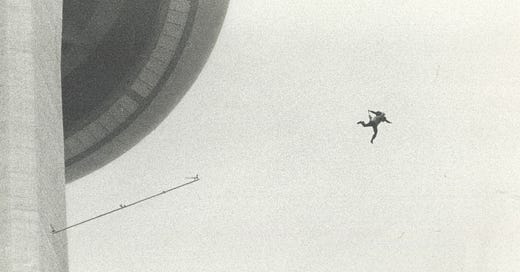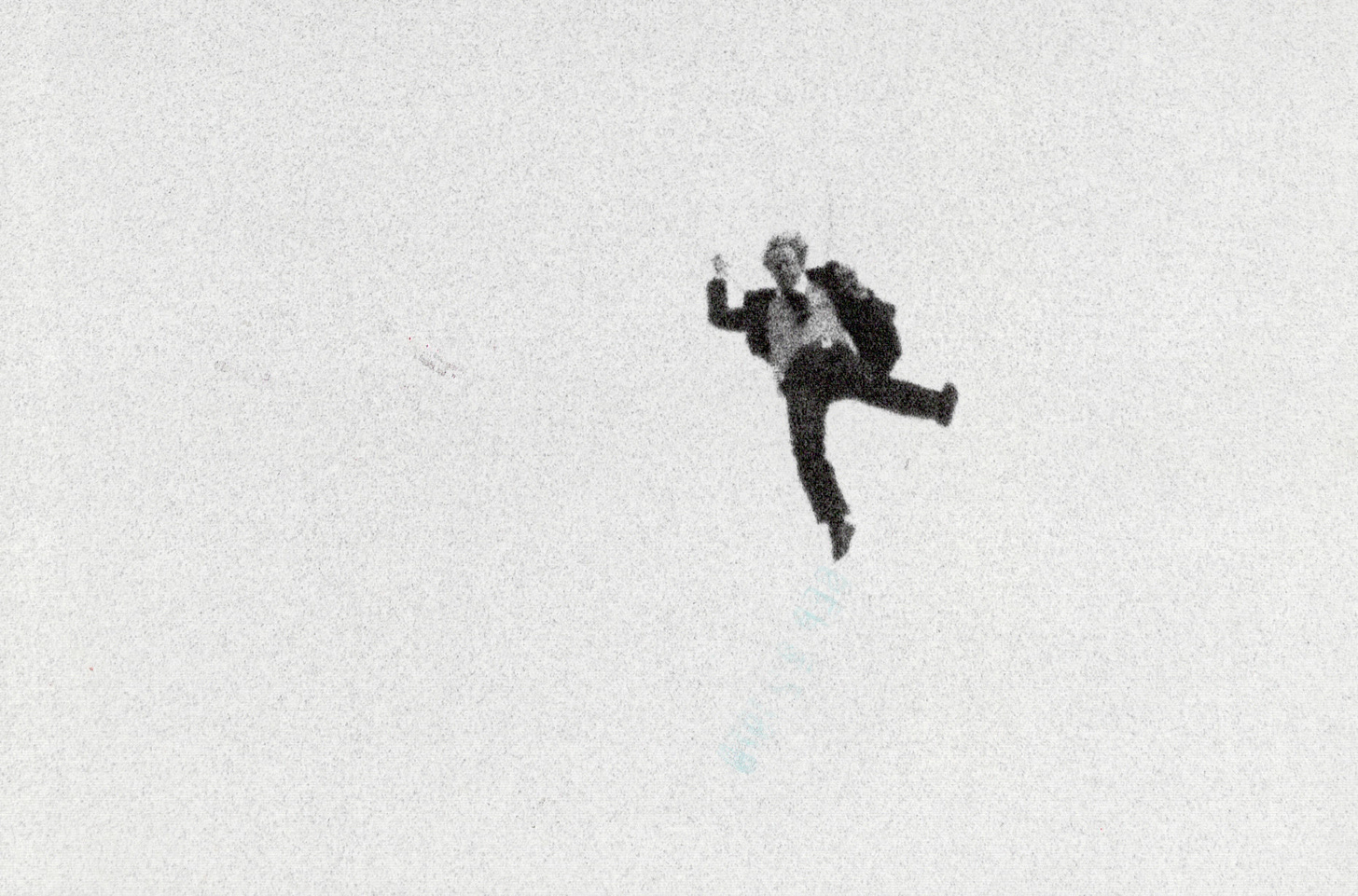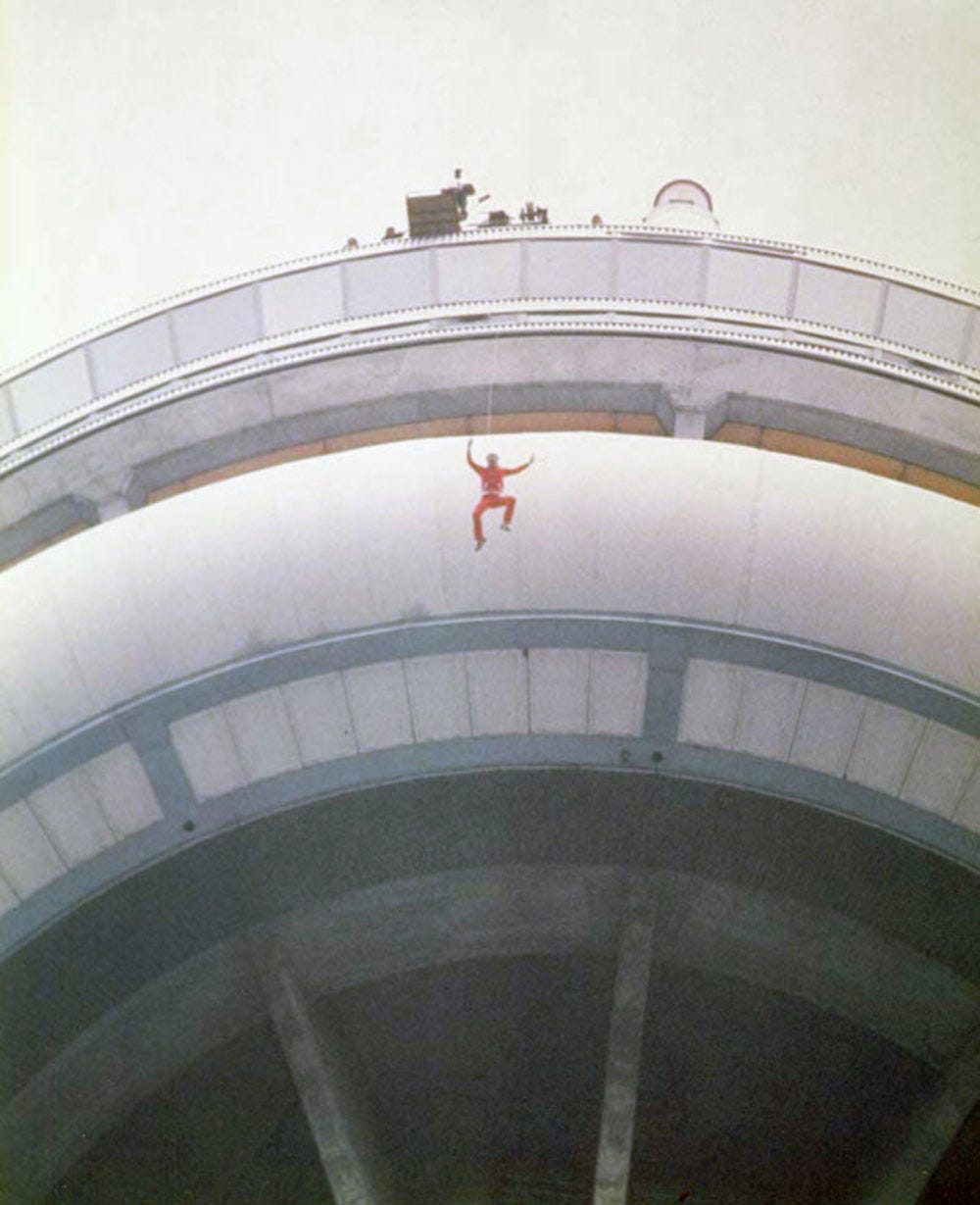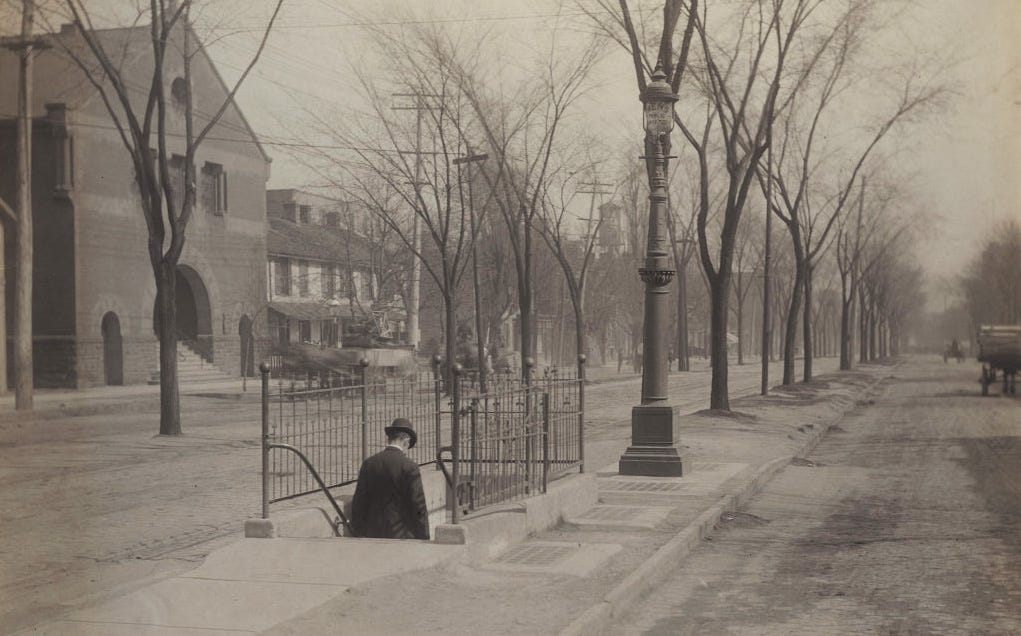The Man Who Jumped Off The CN Tower — And Survived
Plus I begin to unveil the line-up for The Festival of Bizarre Toronto History!
In 1979, a man jumped off the CN Tower. He launched himself into the air more than 300 metres above the ground, plummeting toward the concrete below... And he survived to do it again.
His name was Dar Robinson. He’d spent the seventies earning a reputation as one of Hollywood's greatest stunt performers. He jumped out of helicopters without a parachute, drove over cliffs, leapt from tall buildings, and set plenty of world records doing it... He'd been in Steve McQueen and Clint Eastwood films. Burt Reynolds claimed his was the brave performer around. "In terms of sheer courage,” he once declared, “Dar had no peer."
But the most famous thing he ever did was to jump off the CN Tower, a leap off a ledge more than 100 storeys above Toronto.
And he did it twice.
The first time came when he was Christopher Plummer's stunt double in an action-thriller-rom-com called Highpoint. The movie has a rating of 4.6 on IMDB — even after they spent three years trying to fix it in the editing room. So it's best remembered for Robinson's spectacular jump.
For that first leap off the CN Tower, Robinson hid a parachute under his suit. He plunged toward the earth in a free-fall for more than 200 metres — the chute released just three seconds before he would have slammed into the pavement.
Everything went according to plan. Robinson floated safely to earth, where reporters were waiting for him. "Any doubts?" one asked. "Yeah, I always have doubts!"
But doubts didn't stop from trying again the very next year. And this time, he wasn't going to use a parachute.
This second jump was part of a TV special. Instead of the parachute, he would be attached to a cable system he'd invented himself. There would be nothing but a thin wire standing between Dar Robinson and death. It was just a few millimetres thick.
Of course, they tested it first. The tests did not go well.
Water balloons were dropped over the edge, caught by gusts of wind, and hurled into the side of the tower. Splat. When they followed up by sending down a big bag filled with water, the breaking mechanism on the wire failed. The bag smashed into the ground at full speed.
The jump was postponed again and again, as Robinson waited for the wind to calm down. "I'm afraid of dying," he explained. "I do my job well because it scares me so bad I do everything in the world to make sure that I'm not going to get hurt."
On the morning the conditions were finally looking okay, crowds gathered at the base of the tower. High above them, Robinson was still nervous. Just three weeks earlier, a friend had been killed in a jump.
As he peered down in his bright red tracksuit he admitted he was scared. "If this stunt fails and the cable breaks," he told his partner that day, "I'm going to keep my eyes open to the ground. If they perform an autopsy on me, they'll find sand in my eyes."
He took his seat on the very edge — right where the Edge Walk is today. He told his crew he loved them, leaned out into the empty air, and with a "Ready! Set!" he jumped...
The wire held. One second before his body would have hit the ground, the cord caught him. He was brought softly to earth.
He'd done it. Again.
But it was just six years later that his luck would finally run out. He missed a turn on a motorcycle while performing a stunt for a movie called Million Dollar Mystery (0% on Rotten Tomatoes). After years spent defying mortally, Dar Robinson flew off a cliff to his death.
He would remembered as one of the greatest stunt performers of all-time. And one of the last movies he made before he died would honour his memory — a film much more beloved than the one that claimed him life. Lethal Weapon is dedicated to Dar Robinson.
And his jumps live on, too. You can watch a short video about them here — including footage of both of his death-defying leaps over Toronto.
And speaking of strange stories from our city’s past…
THE FESTIVAL OF BIZARRE TORONTO HISTORY — NEW DETAILS!
Last week, I announced my latest project. The Festival of Bizarre Toronto History is dedicated to exploring strange stories from our city’s past — a week filled with online lectures, panels, interviews, and walking tours featuring some of Toronto's greatest storytellers.
It will run from April 3 to 9. One ticket will get you into all the various events. You can learn more at bizarretoronto.com and get your tickets here.
Now, I get to begin unveiling the line-up!
The Mysterious Disappearance of Ambrose Small
We’ll kick off The Festival of Bizarre Toronto History by exploring one of our city’s greatest mysteries. A little more than 100 years ago, a celebrated theatre mogul sold off his empire, deposited a cheque for a million dollars, and then vanished off the face of the earth. We’ll search for clues and sort through rumours with two of the leading experts on the case.
Katie Daubs is a journalist with The Toronto Star who wrote The Missing Millionaire, a finalist for The Toronto Book Award in 2020. Geordie Telfer is the creator of the Hogtown Empire podcast and the author of Hogtown Empire: The Disappearance of Ambrose Small.
Monday night at 8pm — held over Zoom
A Walking Tour of Weird Queen West
Queen Street is one of our city’s most iconic thoroughfares, and over the centuries it’s been home to some truly odd tales. We’ll bring the festival to a close with a walking tour dedicated to hunting down those strange stories, from the folk music legend who claimed his wife was possessed by a demon, to the subterranean relics of a bygone age. And what better way to end the week than by visiting a spectacular mural dedicated to some of Toronto’s most recent bizarre history.
The tour will be led by Jason Kucherawy, president of the Tourist Guide Association of Toronto and owner of the Tour Guys, Canada’s leading walking tour company — along with Adam Bunch (that’s me!).
Sunday afternoon at 2pm
GET YOUR TICKETS TO THE FESTIVAL HERE
Just a quick reminder before we continue: even if you aren’t able to end the festival, you can support my work by switching to a paid subscription for The Toronto History Weekly. Less than 5% of readers have made the switch so far, which basically means that by offering a few dollars a month you’ll be giving the gift of Toronto history to 20 other people. You can make the switch by clicking here:
QUICK LINKS
The best of everything else that’s new in Toronto’s past…
VICTORIAN GANG NEWS — I’ll kick off this week’s links with one I’ve been looking forward to for a while. I first learned about the Brooks’ Bush Gang this summer while I was researching a tour of the Don Valley, so I was very excited when Bob Georgiou mentioned that he was working on a piece about them. And it’s finally here. The gang of “desperadoes and thieves” terrorized the east end of Toronto in the 1800s. Read more.
RAMONES NEWS — The CAA Theatre on Yonge Street (previous known as the Panasonic and the New Yorker and the Victory) is slated for demolition. It is best known as a Mirvish theatre in recent years, but it also played a seminal role for Toronto’s punk history. It was here that the Ramones played a show in 1976 that revolutionized our city’s music scene. The crowd was small, but it was one of those legendary shows that seems to have inspired nearly everyone there to start their own bands. With months, Toronto was suddenly home to one of the greatest punk scenes on the planet. Read about the demolition plans here. But you should also read Liz Worth’s exceptional oral history of the 1970s Toronto punk scene, Treat Me Like Dirt.
SUBWAY NEWS — “Almost lost in Toronto’s vault of Black history is a case of racial discrimination in the spring of 1964 that nearly prevented the Bloor subway line from opening on time.” For Spacing, Sheila White writes about her uncle Jack White: how he was fired while building the subway line under the Bloor Viaduct, and how his co-workers put down their tools in solidarity. Read more.
BLACKFACE NEWS — Cheryl Thompson appeared on the agenda to talk about how blackface took root in Canada. Watch it.
MODERNIST DEMOLITION NEWS — Alex Bozikovic takes a look at Toronto’s new habit of demolishing modern towers, even those that architectural gems, because the city makes it so much harder to build something tall on a spot that doesn’t already have something tall standing on it. Read more.
STEREOSCOPIC NEWS — Jeremy Hopkin recently got stumbled across some neat stereoscopic photographs taken of Toronto in the 1940s. Sabrina Gamrot wrote about them. Read more.
TORONTO HISTORY EVENTS
TEN OF TORONTO: WHAT DO TEN NEIGHBOURHOODS TELL US ABOUT WHO WE ARE?
Until April 30 — Myseum — 401 Richmond Street West
“Toronto is vast and diverse in people, places, and experiences. With 2.8 million of us who call this dynamic city home, we explore what it means to call Toronto a ‘city of neighbourhoods’ through the lens of 10 distinct communities and themes. In Ten of Toronto, we reflect on our shared histories by looking at the forces that have shaped the city’s neighbourhoods: geography, economy, immigration, finance, urban development, culture, inequality, and social values. Join us, steal away, and stay awhile. We invite you to discover your own path through the stories and histories we’ve unearthed for this exhibit, and lend your voice – what do neighborhoods mean to you?”
Free!
STEP BACK IN TIME: AN INTERACTIVE PHOTO EXHIBITION
March 1 to 31 — Latitude 44 Gallery Framing Décor — 2900 Dundas St. W
“To commemorate our 50th anniversary, The Junction BIA, in partnership with Latitude 44 Gallery Framing Décor, presents an Interactive Photo Exhibition & Silent Auction featuring archival Junction photography from 100 years ago! Each image is accompanied by informative signage, and as a bonus, one of the photographs will be animated with augmented reality (AR) by globally successful artist Benjamin Mitchley. You won’t want to miss this! Immerse yourself in the magical world of augmented reality while discovering how the Junction has developed throughout the years.”
Free!
I TURN MY CAMERA ON: TORONTO ALT-ROCK IN THE 1980s
March 1 to April 30 — The Local — 396 Roncesvalles
West end bar The Local will be displaying photographs taken by Jeremy Gilbert during the golden age of Toronto alt rock.
Free presumably!
TORONTO IN LITERATURE BOOK CLUB: THE BEATLE BANDIT
March 9 — 2pm — Online — Toronto Public Library
& March 16 — 7pm — Toronto Reference Library
“The Toronto in Literature Book Club meets monthly to discuss literature set in, or near, the city of Toronto. Join us for a discussion of The Beatle Bandit: A Serial Bank Robber's Deadly Heist, a cross-Country Manhunt, and the Insanity Plea that Shook the Nation by Nate Hendley. The sensational true story of how a bank robber killed a man in a wild shootout, sparking a national debate around gun control and the death penalty.”
Free!
BY THE LAKE BOOK CLUB: THE UNDERGROUND RAILROAD
March 14 — 7pm — Online and at Assembly Hall in Etobicoke
“Join Adrienne Shadd for a conversation about her book. Meticulously researched and based on never-before-published information on the African-Canadian community of Toronto, this book recounts the journeys of brave travellers, and the network of clandestine routes and safe houses they traversed on the underground railroad seeking freedom in Toronto, and their captivating life after they arrive.”
$10–$28, I believe.
WRITING FAMILY HISTORY — SHAPING GENEALOGY INTO SHAREABLE STORIES
March 27 — 7:30pm — Both online & at Lansing United Church — Toronto Branch of the Ontario Genealogical Society
“Here’s the problem; your family, they don’t want your stuff. No one is stepping forward to say I’ll take your endless boxes of genealogy files. There’s a couple of reasons for that. First, it appears at least on the surface, they’re not interested in your family history. They’ve rolled their eyes every time you attempted to show them new-found document. ... But a book with a collection of family stories they can put on their coffee table or display on a bookshelf is much more likely to appeal to them. It’s also more likely to get read and shared. Lynn Palermo will take you on a storytelling journey demonstrating for you how to turn your research into entertaining and shareable stories. Leave this presentation armed with the first steps to starting a family history narrative and motivated to turn your boxes of documents into an expressive and lasting legacy for future generations.”
Free, I believe!
OUT OF THE SHADOWS: WOMEN & THEIR WORK IN 19TH CENTURY TORONTO
March 29 — 7pm — Northern District Library (Room 224)
“Author and historian Elizabeth Gillan Muir will present an illustrated talk on the influential role women had in the life of the growing city of Toronto during the nineteenth century. Based on the extensive research Dr. Muir did for her recently published book An Unrecognized Contribution: Women and Their Work in 19th-Century Toronto.”
Free!
BLACK HISTORY IN ONTARIO: ONLINE SERIES
This is a series of three online talks hosted by the Toronto Branch of the Ontario Genealogical Society, each one beginning at 7:30pm:
THE UNDERGROUND RAILROAD (April 13)
“Adrienne Shadd will discuss her research for her book The Underground Railroad: Next Stop, Toronto!, co-authored by Afua Cooper and Karolyn Smardz Frost. Her discovery of freedom seeker Deborah Brown, who settled just north of Bloor and Bathurst streets, led to the unearthing of a community of neighbours in this York Township west area, some of whom were immortalized by William Still in his famous work, The Underground Railroad. She will also talk about some of the research and personalities that are profiled in the new 2022 edition of the book.”
THE SEARCH FOR ALFRED LAFFERTY, BLACK EDUCATOR AND LAWYER (April 20)
“In 1869 Alfred M. Lafferty, M.A., Richmond Hill, was a witness to the marriage of William Denis Lafferty, a black farmer who lived in Etobicoke. Who was the man with the same surname and a university degree? Hilary J. Dawson’s research uncovered the story of the Lafferty family, and the successes, challenges, and tragedies they faced. The Lafferty parents arrived from the United States in the 1830s as freedom-seekers. They were illiterate and penniless, yet gave their children the best education they could afford. Alfred Lafferty won prizes for excellence at both Upper Canada College and the University of Toronto. He would become the first Canadian-born black lawyer in Ontario. This presentation will show the resources Hilary used to develop a picture of the Lafferty family.”
BLACK HISTORY IN ONTARIO, 1793–1965
“Winston Anderson will be presenting a timeline of events from the passing of the Act To Limit Slavery in 1793 by Lieutenant-Governor John Graves Simcoe, to 1965 when MPP Leonard Braithwaite pushed for the Separate Schools clause on segregated schools for Blacks to be officially removed from the provincial education policy. He will be discussing a number of people of Black heritage, both free and enslaved people, who shaped Toronto.”
$35
STREETCARS AND THE SHIFTING GEOGRAPHIES OF TORONTO
April 20 — 8:30pm — Online — The Toronto Railway Museum
“What can photos taken by streetcar enthusiasts reveal about the changing nature of cities? This is the question explored by Brian and Michael Doucet in their book Streetcars and the Shifting Geographies of Toronto: a visual analysis of change. The Doucets carefully and meticulously rephotograph these images taken in the 1960s and 70s to bring them into dialogue with contemporary planning, policy, political and public debates.”
ERNEST HEMINGWAY IN TORONTO
April 27 — 2pm — Brentwood Library
“Ernest Hemingway lived in Toronto during 1923 while he worked for the Toronto Star newspaper. He had moved to the city from France with his pregnant wife Hadley, as she preferred to give birth in North America. Their son, John Hadley Nicanor Hemingway, was born at Wellesley Hospital, in Toronto, on October 10, 1923. This special centennial presentation considers the role the area played in Hemingway's apprenticeship as a writer, and in his personal life.”
Free!










